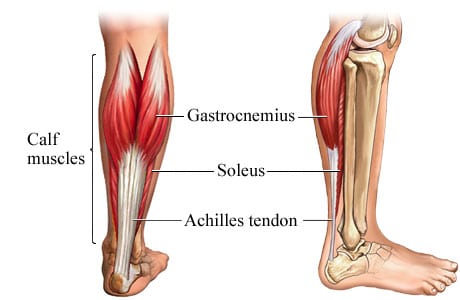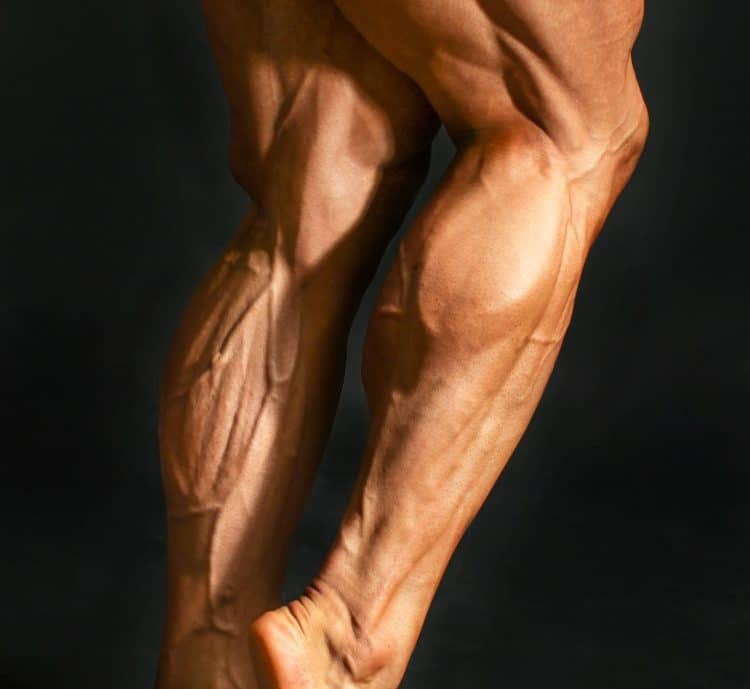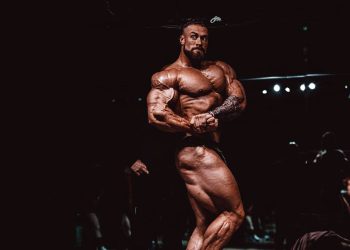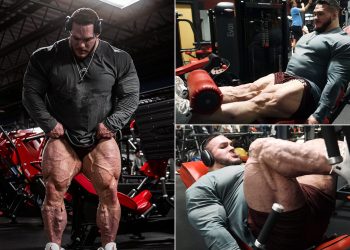During my 30-plus years as a personal trainer, I’ve heard every conceivable excuse for having small, weak calves.
Some people blame it on their calf-fiber makeup, while others complain they’re hard gainers. Others say their calves are simply immune to strength training.
However, in my experience, the real reason calves won’t grow is poor programming.
Think about it like this: In the quest for bigger biceps, most people will do 3-5 sets of 2-3 different exercises once or twice a week. They’ll also train their biceps indirectly during their back workouts. This adds up to a significant amount of volume.
In contrast, most lifters limit their calf training to a few sets of standing and seated calf raises a week. Given this disparity, it’s easy to see why so many folk are unhappy with their calf development.
I’ve been helping clients build muscle for over three decades, and I’ve never had a problem increasing calf size. Trained correctly, the calves, like any other muscle, will grow and get stronger.
So, in this article, I share 12 of the best calf exercises and provide a couple of lower-leg workouts to turn your baby calves into mighty cows!
Best Calf Exercises
- Machine Standing Calf Raise
- Single-Leg Standing Calf Raise
- Dumbbell Standing Calf Raise
- Leg Press Calf Raise
- Captain Morgan Calf Raise
- Donkey Calf Raise
- Smith Machine Standing Calf Jump
- Machine Seated Calf Raise
- Barbell Seated Calf Raise
- Plie Squat Calf Raise
- Tiptoe Farmer’s Carry
- Calf Jumps
1. Machine Standing Calf Raise
The standing calf raise machine is a tried and tested lower-leg builder. Most gyms have a standing calf raise machine, and this exercise allows you to hit your calves hard and heavy in relative safety. If you want bigger, more muscular calves, the standing calf raise is an excellent place to start.
How to perform:
- Stand with the balls of your feet on the footrest and duck under the shoulder pads. Brace your core and extend your knees so you’re standing up straight. Hold the handles for balance.
- Lower your heels down toward the floor until you feel a strong stretch in your calves.
- Next, push up onto your tiptoes. Lift your heels as high as you can.
- Lower your heels and continue for the required number of reps.
Tips:
- Pause at the bottom of each rep to maximize muscle growth.
- Lower your heels slower than you lift them to make this exercise more effective.
- Turn your feet inward to emphasize your outer calves or out to work your inner calves more (1).
2. Single-Leg Standing Calf Raise
No standing calf raise machine? No problem! You can train your calves without specialist equipment, making this an ideal exercise for home workouts. Working one leg at a time also increases the ankle stability demand of your calf workout, potentially increasing muscle engagement and developing your balance.
How to perform:
- Stand with the ball of one foot on the edge of a sturdy step. Use your arms for balance. Hold your other leg behind you or cross your ankles.
- Lower your heel down toward the floor until you feel an intense stretch in your calf.
- Next, push up onto your tiptoes. Lift your heel as high as possible.
- Continue for the required number of reps.
Tips:
- Make sure you do the same number of reps on both legs.
- Hold a dumbbell in one hand to make this exercise more demanding.
- You can also do this exercise using a calf raise machine:
3. Dumbbell Standing Calf Raise
The standing dumbbell calf raise requires a lot of balance, making it an ideal exercise for experienced lifters. It also enhances ankle stability, so it’s useful for athletes and anyone looking for a more functional calf workout. However, if hypertrophy is your goal, you will probably get better results from a more stable lower leg exercise.
How to perform:
- Hold a dumbbell in each hand with your arms by your sides. Pull your shoulders back and down and brace your core.
- Stand with the balls of your feet on the edge of a sturdy step.
- Lower your heels down as far as possible to get a deep stretch in your calves.
- Next, rise up as high as you can onto your tip toes.
- Alternate between these two positions for the duration of your set.
Tips:
- Hold one dumbbell instead of two if you need to use a hand for balance.
- You can also do standing calf raises with a resistance band instead of dumbbells.
- Do this exercise on the floor instead of a step to make balancing easier. However, the reduced range of motion means this variation is a little less effective.
4. Leg Press Calf Raise
The leg press calf raise is another popular exercise among bodybuilders. With plenty of back support, this option is ideal for anyone who wants to train their calves with heavy loads. However, take care that your feet don’t slip off the footplate, as this could cause severe injury.
How to perform:
- Climb onto the leg press machine and place the balls of your feet on the lowermost edge of the footplate.
- Extend your legs and push the weight up.
- Keep your knees stationary and flex your ankles, lowering the weight until you feel an intense stretch in your calves.
- Next, point your toes as hard as you can.
- Alternate between these two positions for the desired number of reps.
Tips:
- Reduce your risk of injury by ensuring your shoes are dry, and your feet are not too close to the edge.
- Turn your feet in to emphasize your outer calves or outward to work your inner calves more.
- You can also do this exercise using one leg at a time.
5. Captain Morgan Calf Raise
We have a saying in the fitness industry: If you always do what you have always done, you’ll always get what you always got. In other words, if you want to change your body, you must also change your workouts. The Captain Morgan calf raise is unique, and adding it to your workouts should help reignite your muscle gains!
How to perform:
- Set up a platform so it’s about mid-thigh height. Hold one dumbbell in each hand and pull your shoulders down and back. Brace your core.
- Place one foot on the platform and move the other leg back into a lunge position. Your front knee should be bent, and your rear heel should be flat to the floor.
- Push off the ball of your foot and extend your ankle. Contract your calf as hard as possible.
- Return your heel to the floor and then repeat.
Tips:
- Do the same number of reps on both legs.
- Move your extended leg back to increase the range of motion for your calf.
- You can also do this exercise using one dumbbell and your other hand is free for balance and support.
6. Donkey Calf Raise
The donkey calf raise is a traditional bodybuilding exercise. It puts your calves in a very stretched position, which many believe is ideal for maximizing muscle growth. This exercise is not easy, and you must be flexible to do it correctly. However, if you can perform it safely, you’ll find it’s a very effective calf builder.
How to perform:
- Stand with the balls of your feet on the edge of a sturdy step. Brace your core.
- Lean forward at the hips and rest your hands on a bench for support.
- Keeping your legs straight, flex your ankles and lower your heels down toward the floor.
- Rise onto your tiptoes, squeezing your calves as hard as possible.
- Lower your heels and repeat.
Tips:
- Pause at the bottom of each rep to make this exercise more effective.
- Use a weighted chin/dip belt to load this exercise and make it more demanding.
- You can also do this exercise old-school style, with a partner sitting on your hips:
7. Smith Machine Standing Calf Jump
Most calf exercises use a slow, controlled motion. While this is generally effective, it’s not the only way to train your calves. Explosive movements may be even more potent as they preferentially recruit your type IIB fast-twitch muscle fibers. These muscle fibers have the greatest potential for growth.
How to perform:
- Rack and hold the Smith machine bar across your upper back. Stand on the edge of a sturdy step. Brace your core.
- Bend your legs and descend into a shallow squat.
- Extend your legs and “jump” up onto your tiptoes so your legs are straight.
- Bend your legs and repeat.
Tips:
- Make sure your step is sturdy and won’t move.
- Once you have mastered the movement, this exercise works well with heavy loads for low to medium reps.
- You can also do this exercise on a standard calf raise machine.
8. Machine Seated Calf Raise
Seated calf raises emphasize your lower calf muscle – called your soleus. This muscle is involved in all other calf exercises, but plantarflexing your ankle with your knee bent hits it harder.
How to perform:
- Sit on the machine with the balls of your feet on the edge of the footrest and the pad resting across your lower thighs. Unrack the weight.
- Lower your heels down toward the floor until you feel a deep stretch in your calves.
- Push up onto your tiptoes and repeat.
Tips:
- Do not lean back or pull on the handles. Doing so takes work away from your calves.
- Pause at the bottom and top of each rep to make seated calf raises more effective.
- This exercise works best with light to moderate weights and medium to high reps, e.g., 12-20.
9. Barbell Seated Calf Raise
While most gyms have seated calf raise machines, some do not. Plus, if you train at home, you probably won’t have access to a seated calf raise machine. The good news is that you can replicate this exercise with nothing more than a bench, a barbell, and a step.
How to perform:
- Sit on an exercise bench or sturdy chair. Place the balls of your feet on the edge of a low step. Rest and hold a barbell across your thighs.
- Lower your heels down toward the floor to get a good stretch in your calves.
- Next, extend your ankles and rise up onto your tiptoes.
- Alternate between these two positions for the required number of reps.
Tips:
- This exercise works equally well with an EZ bar.
- Use a bar pad or folded gym mat for comfort.
- You can also do this exercise with dumbbells or using one leg at a time:
10. Plie Squat Calf Raise
The plie squat is a common bodyweight leg exercise emphasizing the glutes and inner thighs. However, you can also use a modified version of this exercise to work your calves. This is an excellent option for home workouts and anyone who wants to train multiple leg muscles simultaneously.
How to perform:
- Stand with your feet roughly 1 ½ shoulder-widths apart. Turn your toes outward. Raise your arms so they’re parallel to the floor. Brace your core.
- Bend your legs and descend into a deep squat.
- Keeping your legs bent, rise up onto your tiptoes.
- Lower your heels to the floor and repeat.
Tips:
- Hold onto a bench or the back of a chair for balance if necessary.
- You can also do plie squat calf raises with an alternating leg action.
- Hold a weight to make this exercise harder.
11. Tiptoe Farmer’s Carry
This is one of my favorite calf exercises! While doing it will raise plenty of eyebrows at your gym, you’ll love just how effective it is. Go heavy and push for the burn; this exercise is the perfect start, middle, or end to any calf workout.
How to perform:
- Hold a heavy weight in each hand. Brace your core and pull your shoulders down and back.
- Next, rise up onto your tiptoes.
- Keeping your heels off the floor, go for a walk around your training area.
- Continue until you are unable to keep your heels off the ground.
Tips:
- Do this exercise without weight to make it easier.
- Use dumbbells or kettlebells as preferred.
- Use gym chalk to stop your hands from slipping. Alternatively, you can use lifting straps to reinforce your grip.
12. Calf Jumps
Calf jumps are a plyometric or explosive exercise for your lower legs. This movement increases muscle power. As such, it’s an excellent option for athletes from all sports, especially runners. Plus, it will also add size to your calves.
How to perform:
- Stand with your feet together and your arms by your sides.
- Keep your knees as straight as possible, and jump up and down on the spot.
- Use your arms for extra momentum and height.
- Continue until you feel your jumps are losing power or height.
Tips:
- Do this exercise on a forgiving surface to reduce your risk of injury.
- Hold dumbbells to make this movement more demanding.
- You can also do this exercise using one leg at a time, i.e., calf hops.
Calf Anatomy Basics
You don’t need an in-depth knowledge of anatomy to build bigger, stronger calves. However, a grasp of the basics will make it easier to choose the best exercises for your workouts. So, let’s peel back the skin and take a quick look at the muscles that make up your calves.

Gastrocnemius
The gastrocnemius is the outermost and biggest of the calf muscles. It crosses the ankle and the knee and affects both these joints. The gastrocnemius comprises two heads – medial and lateral. Its primary function is plantarflexion (extension) of the ankle, and it also has a minor role in knee flexion.
Soleus
The soleus is a flat, long muscle that lies beneath and below the gastrocnemius. The soleus crosses just one joint – your ankle. Its primary function is plantarflexion (extension) of the ankle.
Plantaris
The plantaris is a slender muscle that helps to plantarflex the ankle. It also aids in knee flexion, although this function is quite weak. The plantaris is relatively small and overshadowed by the larger, more powerful soleus and gastrocnemius. Consequently, it doesn’t contribute much to calf size.
Together, these three muscles are often known as the triceps surae.
However, where the soleus and gastrocnemius attach to the calcaneus or heel bone via the Achilles tendon, the plantaris has its own tendon. Their collective name refers to their shared function of plantarflexing the ankle.
Best Calf Workout Routine
If you want bigger calves, you need to make them a training priority. A few sets of standing or seated calf raises once a week won’t get the job done. So, let’s cure those chicken leg blues with a dedicated calf-building routine!
Do each of the following workouts once a week. Ideally, you should separate them by a couple of days, e.g., Monday and Thursday.
But, before you begin, make sure you prepare your muscles and joints with a thorough warm-up.
Begin with some light cardio, e.g., walking or jogging, followed by a few ankle mobility and calf dynamic flexibility exercises. Finish your warm-up with a couple of sets of light calf raises to get your blood pumping.
Ready? Then let’s get to work!
Calf Workout #1
| # | Exercise | Sets | Reps | Recovery |
| 1 | Machine Standing Calf Raise | 4 | 8-10 | 90 seconds |
| 2 | Donkey Calf Raise | 3 | 10-12 | 60 seconds |
| 3 | Barbell Seated Calf Raise | 3 | 10-12 | 60 seconds |
| 4 | Calf Jumps | 2 | 15-20 | 60 seconds |
Calf Workout #2
| # | Exercise | Sets | Reps | Recovery |
| 1 | Leg Press Calf Raise | 4 | 8-10 | 90 seconds |
| 2 | Captain Morgan Calf Raise | 3 | 10-12 | 60 seconds |
| 3 | Machine Seated Calf Raise | 3 | 10-12 | 60 seconds |
| 4 | Tiptoe Farmer’s Carry | 2 | Max | 60 seconds |
Calf Exercise and Workout FAQ
Do you have a question about these calf exercises, workouts, or lower leg training in general? No problem, because I’ve got the answers. Need more info? Drop me a line in the comments section below, and I’ll get back to you as soon as I can.
1. Is calf size and shape genetic?
Muscle size and shape are strongly influenced by genetics. Unmodifiable factors, including tendon and muscle belly length and fiber makeup, determine how your muscles look and function.
That said, even the hardest of hardgainers can build bigger calves if they train with sufficient intensity and consistency. While your lower legs may never compare to those of a pro bodybuilder, you can always make them bigger and stronger.
2. Why are calves such a stubborn muscle group?
In my experience, it’s not that calves are stubborn. Instead, I believe many people fail to train them hard and often enough. So, before you label your calves as stubborn or non-responsive, try working them twice a week with a wider range of exercises.
Better still, take my tried and tested calf routine for a spin. Three months from now, your lower legs will be unrecognizable!
3. What tips and tricks can I use to maximize calf growth?
Are you stuck in a calf-training rut? I feel your pain! Here are three tips and tricks you can use to get your gains back on track.
Blood flow restriction or occlusion training reduces the blood flow into your muscles, forcing them to work harder than usual. While this might sound hokey, this is a proven muscle-building strategy backed by research (2). However, be warned, it can be pretty painful!
Lengthened partials involve doing shortened reps with your muscles in a stretched position, e.g., at the bottom of a calf raise. Research indicates that this can enhance hypertrophy, and this method has been used successfully for calf training (3).
Training to failure is one of the best ways to maximize muscle growth (4). However, you may get even better results if you push your muscles past failure with drop sets and forced reps. These methods expose your muscles to more mechanical and metabolic stress, leaving them with no choice but to grow.
4. How many sets and reps should I use to train my calves?
Contrary to popular opinion, you can use almost any rep range to build muscle – from 6-8 to 30 or more. The main thing you need to do is train to failure. Providing you exhaust your muscles, it really doesn’t matter if you lift light weights for high reps or heavier weights for low reps (5). That said, sets of 3-5 are still the best way to build maximal strength.
In terms of sets, 3-5 per exercise should be sufficient for most people. If you feel like you need to do more, you are either not training close enough to failure or are resting too long between sets.
In summary, 3-5 sets of 6-30 reps will build muscle if you train close to failure. However, the classic 8-12 rep range is still valid if that’s what you prefer.
5. How often should I train my calves?
While some people can make good gains by training their calves once a week, in my experience, two or even three weekly workouts are better. The calves can withstand a lot of punishment and seem to recover quite quickly, so 2-3 workouts per week should produce more growth than a single workout.
That said, one workout per week is enough to maintain your calf size. So, if you are happy with your current calf development, you can relegate them to one weekly session.
Closing Thoughts
Slow-growing calves are a common problem. However, a lot of lifters are quick to blame their genetics when the real problem is poor exercise choices and too little training.
This article contains everything you need to grow massive lower legs. I’ve listed 12 of the best calf exercises and shared two tried-and-tested calf-building workouts. Put everything you’ve learned into action, and you’ll soon be on your way to lower legs you can be proud of.
Make your calf training a priority, and irrespective of your genetics, your calves will grow!
Read also: Best Old-School Calf Workouts & Exercises
References:
- Nunes JP, Costa BDV, Kassiano W, Kunevaliki G, Castro-E-Souza P, Rodacki ALF, Fortes LS, Cyrino ES. Different Foot Positioning During Calf Training to Induce Portion-Specific Gastrocnemius Muscle Hypertrophy. J Strength Cond Res. 2020 Aug;34(8):2347-2351. doi: 10.1519/JSC.0000000000003674. PMID: 32735428.
- Gavanda S, Isenmann E, Schlöder Y, Roth R, Freiwald J, Schiffer T, Geisler S, Behringer M. Low-intensity blood flow restriction calf muscle training leads to similar functional and structural adaptations than conventional low-load strength training: A randomized controlled trial. PLoS One. 2020 Jun 30;15(6):e0235377. doi: 10.1371/journal.pone.0235377. PMID: 32603351; PMCID: PMC7326162.
- Kassiano W, Costa B, Kunevaliki G, Soares D, Zacarias G, Manske I, Takaki Y, Ruggiero MF, Stavinski N, Francsuel J, Tricoli I, Carneiro MAS, Cyrino ES. Greater Gastrocnemius Muscle Hypertrophy After Partial Range of Motion Training Performed at Long Muscle Lengths. J Strength Cond Res. 2023 Sep 1;37(9):1746-1753. doi: 10.1519/JSC.0000000000004460. Epub 2023 Apr 3. PMID: 37015016.
- Refalo MC, Helms ER, Trexler ET, Hamilton DL, Fyfe JJ. Influence of Resistance Training Proximity-to-Failure on Skeletal Muscle Hypertrophy: A Systematic Review with Meta-analysis. Sports Med. 2023 Mar;53(3):649-665. doi: 10.1007/s40279-022-01784-y. Epub 2022 Nov 5. PMID: 36334240; PMCID: PMC9935748.
- Lasevicius T, Ugrinowitsch C, Schoenfeld BJ, Roschel H, Tavares LD, De Souza EO, Laurentino G, Tricoli V. Effects of different intensities of resistance training with equated volume load on muscle strength and hypertrophy. Eur J Sport Sci. 2018 Jul;18(6):772-780. doi: 10.1080/17461391.2018.1450898. Epub 2018 Mar 22. PMID: 29564973.
Article Updates Timeline:
Our editorial team experts constantly update the articles with new information & research, ensuring you always have access to the latest and most reliable information.
January 16, 2024
Updated By
Tom Miller, CSCS
Reviewed By
Dr. Malik
January 12, 2024
Written By
Patrick Dale, PT, ex-Marine
Reviewed By
Editorial Team
Fact Checked By
Dr. Malik












